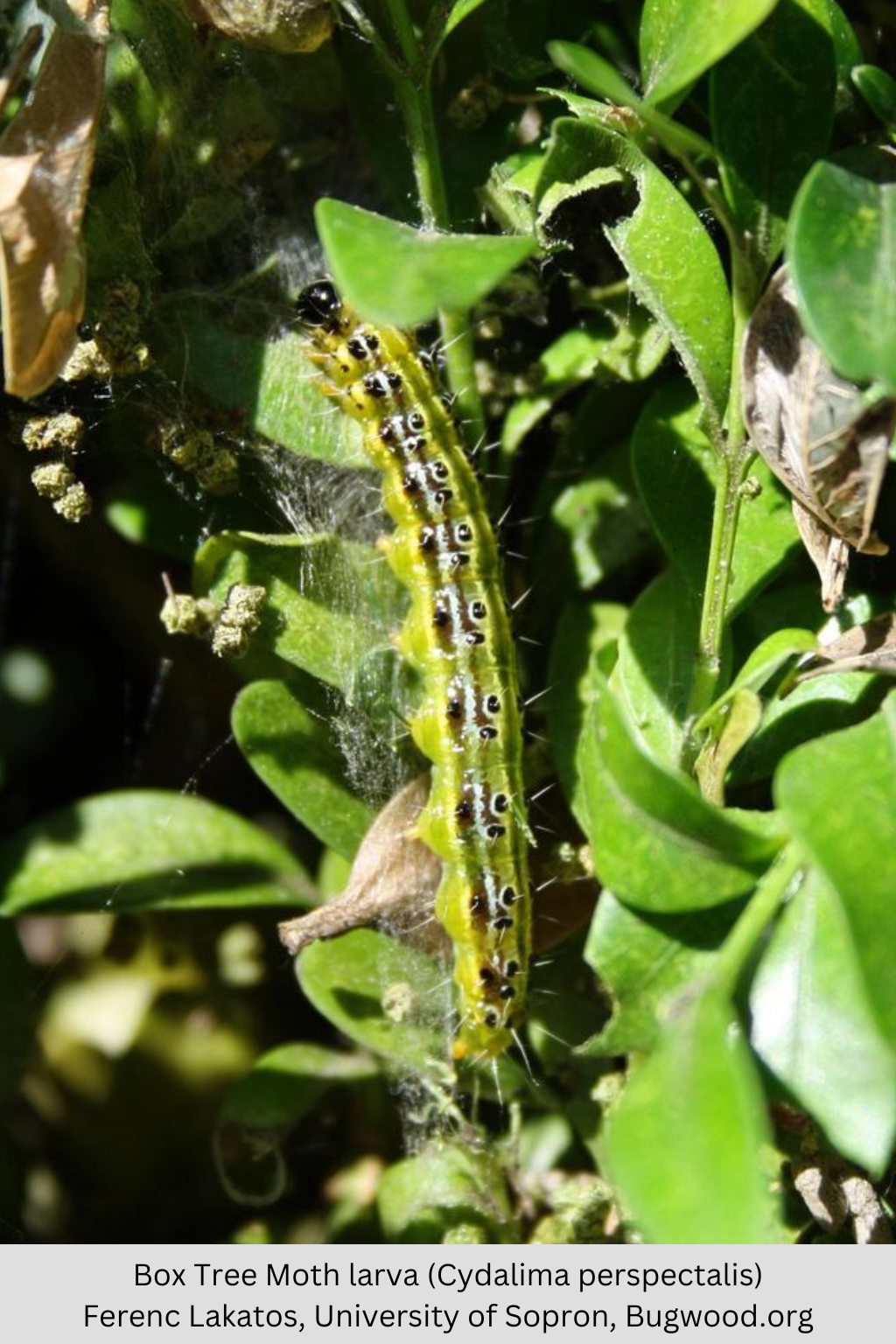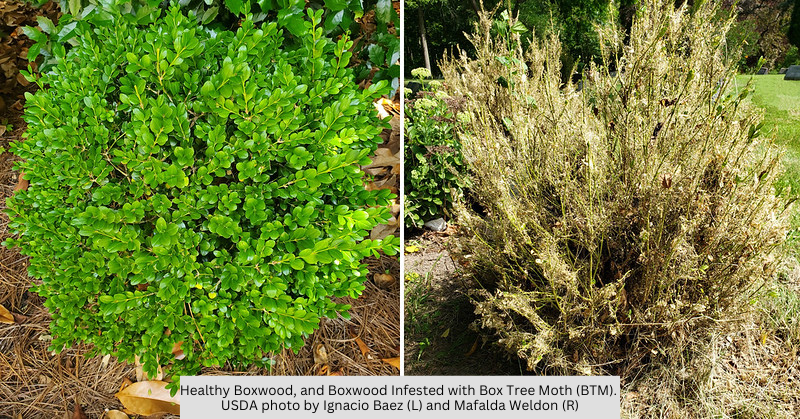 The box tree moth (Cydalima perspectalis) or (BTM) is an introduced, invasive pest that feeds on ornamental boxwood plants (Buxus spp.) BTM is native to China, Japan, and Korea. In 2007, the pest was detected in Germany, likely introduced on infested nursery stock, and it has since quickly spread across Europe into Western Asia and Northern Africa. In 2018, BTM was first detected in North America, after infestations were detected in Ontario, Canada.
This invasive pest has not yet been detected in Wisconsin. However, BTM has now been found in several US states, including New York (2021), Michigan (2022), Massachusetts (2023), Ohio (2023), Delaware (2024), Pennsylvania (2024), Maryland (2025), Virginia (2025), and West Virginia (2025).
The box tree moth (Cydalima perspectalis) or (BTM) is an introduced, invasive pest that feeds on ornamental boxwood plants (Buxus spp.) BTM is native to China, Japan, and Korea. In 2007, the pest was detected in Germany, likely introduced on infested nursery stock, and it has since quickly spread across Europe into Western Asia and Northern Africa. In 2018, BTM was first detected in North America, after infestations were detected in Ontario, Canada.
This invasive pest has not yet been detected in Wisconsin. However, BTM has now been found in several US states, including New York (2021), Michigan (2022), Massachusetts (2023), Ohio (2023), Delaware (2024), Pennsylvania (2024), Maryland (2025), Virginia (2025), and West Virginia (2025).
Signs and Symptoms of BTM
 BTM larvae, or caterpillars, are the destructive life stage for this pest. The larvae feed exclusively on boxwood plants causing severe defoliation, and if left unchecked, boxwood death. BTM is able to do a lot of feeding damage in a short amount of time. Younger caterpillars strip the undersides of leaves, giving the top of the leaves a peeled effect. Older caterpillars consume almost the entire leaf, except for the midrib. A heavy BTM infestation can cause plants to become completely defoliated. If there is no foliage left on the plants or on the ground, caterpillars feed on boxwood bark, killing branches, individual plants, and entire boxwood plantings. Additional signs of BTM infestation include greenish-black frass pellets (excrement) that resemble sawdust, silk webbing on leaves, brown and white adult moths, and clusters of tiny egg masses on boxwood leaf undersides.
BTM larvae, or caterpillars, are the destructive life stage for this pest. The larvae feed exclusively on boxwood plants causing severe defoliation, and if left unchecked, boxwood death. BTM is able to do a lot of feeding damage in a short amount of time. Younger caterpillars strip the undersides of leaves, giving the top of the leaves a peeled effect. Older caterpillars consume almost the entire leaf, except for the midrib. A heavy BTM infestation can cause plants to become completely defoliated. If there is no foliage left on the plants or on the ground, caterpillars feed on boxwood bark, killing branches, individual plants, and entire boxwood plantings. Additional signs of BTM infestation include greenish-black frass pellets (excrement) that resemble sawdust, silk webbing on leaves, brown and white adult moths, and clusters of tiny egg masses on boxwood leaf undersides.
Identification and Life Cycle
Box tree moth may have one to five generations per year, depending on the climate in areas they have been introduced. This means that life cycles overlap and caterpillars and adult moths can be seen together throughout the growing season. The overwintering life stage are the late instar caterpillars that hibernate from October or November until at least April. Newly hatched larvae or caterpillars are up to half-inch long and are greenish yellow, with black heads. As the caterpillars get older, they develop hairy, lime green bodies with black stripes, white spots, and shiny black heads. Caterpillars take about 14 days to mature. Pupation occurs next and takes about 14 days. Pupae are typically found in webbing. They are green with brown stripes and start showing an outline of wings on their body as they grow. There are two adult moth color variants observed in both sexes; the more common has white wings with thick dark brown borders while the less common has brown wings with a white streak on the forewing. Adult moths are very mobile, flying from three to six miles to up to 20 miles per year. BTM adults live for about two weeks and are most active at dusk and throughout the night. Adults mate, with females laying clusters of five to 20 flat, pale yellow minute eggs on boxwood leaf undersides.
Potential BTM Regulations and Compliance Agreements
Following the detection of BTM in New York in 2021, the USDA's Animal Plant Health Inspection Service (APHIS) established a BTM quarantine to reduce pest spread in 2022. Since that time, APHIS has worked with states to quarantine all or parts of states
where this pest has been confirmed. If BTM is detected in Wisconsin, staff would investigate to determine whether it is a regulatory interception or an established population. For interceptions (e.g., a single dead adult, other nonviable life stage, or an infestation of a limited number of plants), infested plants would be destroyed to reduce risks of BTM establishment. If a reproducing population is found, DATCP would likely take steps to quarantine the known infested area. If BTM becomes established, then USDA APHIS and DATCP may propose a permanent BTM quarantine rule. In this case, nurseries within the quarantine that ship boxwood outside the infested area, would enter into a
compliance agreement with DATCP. Regulated articles would likely include whole boxwood plants, all plant parts, pieces, cuttings, clippings, and debris. The compliance agreement provides conditions required for the interstate and intrastate movement of boxwood plants from areas regulated for BTM to non-regulated areas. All stock would have to be inspected in the field and prior to shipping; trapping and treatments would be required; nursery staff would take BTM training; and shippers would need to notify receiving states of incoming boxwood. Please refer to the
USDA Box Tree Moth compliance agreement template and the
webinar from the Horticultural Research Institute on BTM compliance agreements for more information.
Control Methods

In states with established BTM populations, control methods have been implemented to manage this pest. For smaller infestations, homeowners can monitor moth populations with pheromone traps. Small infestations can be culturally controlled by removing and destroying infested plants, and by pruning out affected branches. Horticultural oil and insecticidal soaps may be used to control young caterpillars. There are also commercially labeled broad-spectrum pesticides that control caterpillars on ornamental plants. However, these products can negatively impact pollinators, natural enemies, and other nontarget organisms. The biopesticide
Bacillus thuringiensis var.
kurosaki (Btk) has also demonstrated effectiveness against BTM larvae without impacting most nontargets. For additional information about control management, please refer to the Box Tree Moth: Management Guide.
If You Suspect Box Tree Moth in Wisconsin, Report It Immediately
Nurseries, landscapers, and residents should monitor their boxwoods and if you suspect a box tree moth infestation, please report it to the Pest Hotline by calling (866) 440-7523 or emailing datcppesthotline@wi.gov. For DATCP to verify the detection, it is essential to include clear, close-up photos and include the location with your report. Wisconsin nursery growers and dealers should also contact their
local nursery inspector.